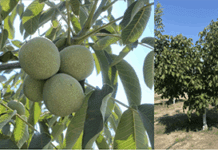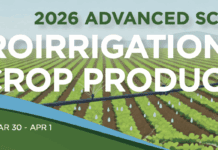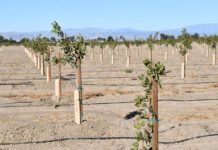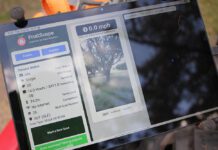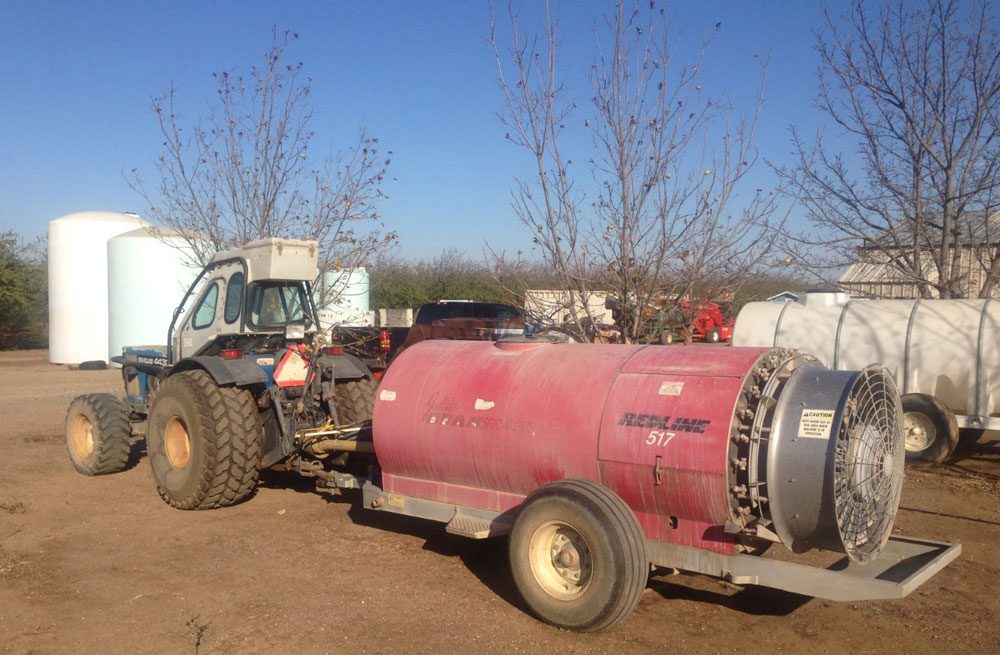
Sprayer maintenance is one of the most important steps a grower can take going into the season to ensure they get the most out of their crop protection inputs, according to Franz Niederholzer, UCCE farm advisor for Colusa, Sutter and Yuba counties. And with so many uncertainties facing nut growers these days, getting top value out of crop inputs is critical.
“Growers are looking at rising costs and prices being variable as well as uncertainties with global trade and supply chain issues,” Niederholzer said. “Now is the time to look carefully at costs and expenditures. And if you are going to spend the money [on a crop input], make sure it works,” he said.
Starts with Calibration
Checking screens, pressure gauges, nozzles and other sprayer parts is critical and should be done each offseason, Niederholzer said. But the most important step a grower can take this offseason to ensure a sprayer is operating efficiently is sprayer calibration.
“Take it out when you are not under the gun,” Niederholzer said. “When you’ve got a little bit of time, go out on a flat piece of ground, fill it full of clean water and calibrate it. Find out what your sprayer is putting out at the operating settings that you commonly use.
“And, while you are doing that, look for leaks, look for plugged screens or nozzles and generally see how your sprayer is working,” he said.
An improperly calibrated sprayer can lead to overapplication of crop inputs, which costs farmers money and wastes product, and what can be worse, underapplication.
“Bill Olson, retired UCCE farm advisor for Butte County, used to say the most expensive spray job is the one that doesn’t work,” Niederholzer said. “The biggest downside is not putting on enough material. If you are under the label rate, that can’t be good.”
Calibrating a sprayer can seem like a daunting task for those unfamiliar with it, Niederholzer said. But it isn’t as hard as it first seems.
“Once you get the hang of it, it is not that complicated,” he said. “It is like so many things: Before you do it, you are really nervous about it, but once you do it, it is like, ‘Okay, now I get it.’ It just takes getting familiar with it, getting comfortable with it.”
There are several educational tools available for people interested in learning how to calibrate a sprayer, Niederholzer said, including an on-demand course that he and Lynn Wunderlich, UCCE farm advisor in the Central Sierra, recently developed with help from UC IPM Course Development Experts Cheryl Reynolds and Petr Kosina.
“We spent a lot of time and effort on that video,” he said. “That is a tool I would point growers, managers and operators to.”
Also, he said, most UC ANR crop production literature has a chapter on sprayer applications and calibration. And, he said, UC ANR Extension Specialist in Ag Application Peter Larbi is planning an in-depth airblast sprayer training course for May 16 to 18. Niederholzer suggested that growers save those dates and look for registration information in UCCE newsletters and magazine articles in coming weeks.
Before calibrating a sprayer, Niederholzer said growers or managers should start with standard sprayer maintenance.
“Good maintenance involves looking at a lot things, even if it just a quick check,” Niederholzer said. “It doesn’t have to be a deep dive, but it is important to check all the parts that work in the system.”
Be sure to check all screens from the tank to the nozzles to make sure they are clean and working properly. And check to see if nozzles are plugged or worn. If nozzles are worn beyond a manufacturer’s specs, they should be replaced, Niederholzer said.
“It can cost you far more to continue using them than the replacement costs,” he said.
Also, he said, don’t hesitate replacing pressure gauges. They are a relatively inexpensive yet critical part of a sprayer.
Calibrate to Canopy
One money-saving strategy that Niederholzer said growers should consider this offseason is to separate calibrations for different times of the year depending on canopy.
The practice, which involves increasing ground speed early in the season when canopies are light, and slowing during full leaf-out, can provide significant savings in labor, fuel and water.
“The sprayer shouldn’t be working as hard at bloom as at full leaf-out,” Niederholzer said. “There is just not that much plant tissue to cover at bloom, and there is no resistance of the canopy because there are no leaves. So, you can drive a little bit faster. You use the same rate of material per acre, but use less water, and that means you don’t fill up as often.
“So, there are significant savings in time and labor,” he added. Driving three miles an hour during bloom versus two miles an hour in season, for example, can save one-third in labor costs, he said.
“In this day and age, especially with nut prices where they are, why waste money?” he said. “You aren’t changing your pesticide rate, but you are changing your gallonage, which makes for a more concentrated spray. And because you are driving faster, that cuts down on drift, which makes your neighbors happy.
“It requires a little extra work,” he continued. “You have to stop and establish your ground speed and your nozzle flow for two different spray volumes (gallons per acre) for the same orchard. But in most sprayers these days, you have flip-over nozzles, or several nozzles you can turn on or off at the same spot on the sprayer manifold. So, you can set up those two different calibrations in the offseason, and when the time comes to change over after petal fall, you just change up the nozzles and adjust gearing and RPMs to deliver the pre-determined gallons per acre.”
If employing this strategy, he advised growers to make sure sprayer operators know gearing and nozzles needed for job or calibration at hand. “That is critical,” he said. “But when that is done, you are set. You don’t have to do all that much work in season.”
One Day’s Work
The time it takes to prepare a sprayer for the season, typically about a day, is miniscule when compared to the benefits a grower can gain from a properly maintained sprayer, Niederholzer said. And it can be done any time in the offseason.
“That is the nice thing about this,” Niederholzer said. “It is a task that isn’t time-dependent. If you aren’t planning to put on a dormant spray, you just have to make sure your sprayer is ready for your pink-bud timing.
“Think of the dollars of chemical that go through one sprayer in a season,” he said. “Forget the labor involved. Just think about the cost of chemical that goes out.
“My argument is it is worth a day of the manager’s or a grower’s time before the season starts to make sure that the equipment that delivers all that expense is working like you want it to.”
People interested in taking the sprayer calibration course Niederholzer referenced can go to campus.extension.org/enrol/index.php?id=1787.
The course is free to the public, but costs $60 if a person wants the 2.5 hours of continuing education credits that are available with the class.




